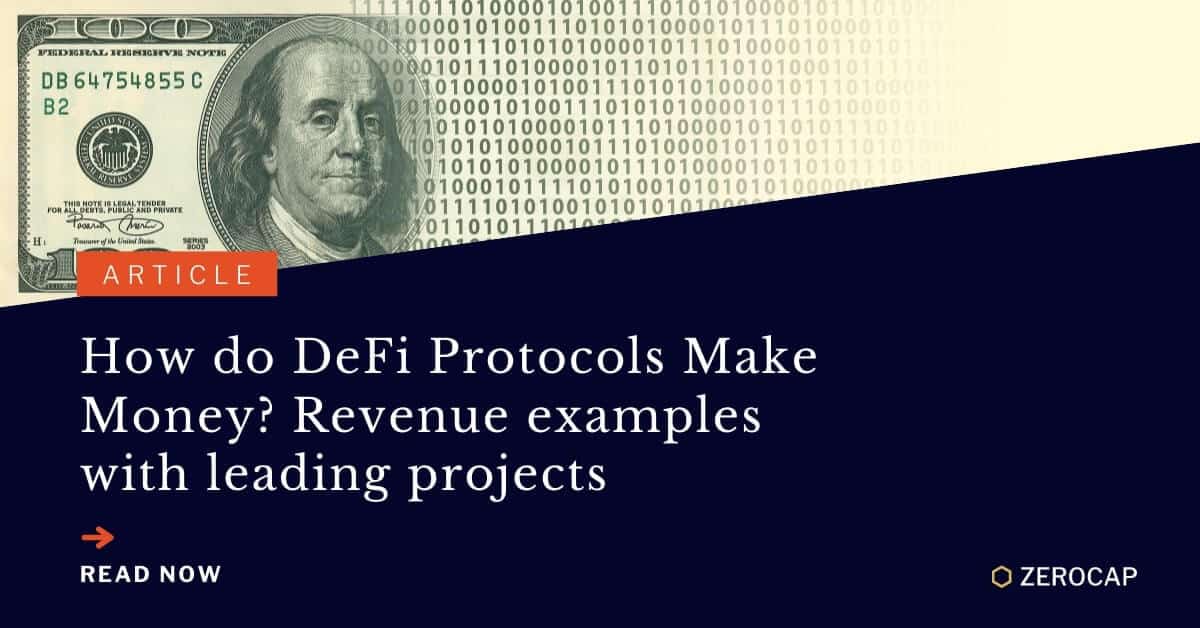Content
- Are DeFi Protocols Companies?
- Decentralised Exchanges
- Uniswap
- Curve Finance
- Decentralised Derivative Exchanges
- dYdX
- Lending Protocols
- Maker
- Aave
- Conclusion
- FAQs
- What are DeFi Protocols and How Do They Generate Revenue?
- How Do Decentralised Exchanges (DEXs) Like Uniswap and Curve Finance Generate Revenue?
- What are Decentralised Derivative Exchanges and How Do They Make Money?
- How Do Lending Protocols Like Maker and Aave Generate Revenue?
- What are the Challenges Faced by DeFi Protocols in Terms of Profitability?
- About Zerocap
5 Oct, 22
How do DeFi Protocols Make Money? Revenue examples with leading projects

- Are DeFi Protocols Companies?
- Decentralised Exchanges
- Uniswap
- Curve Finance
- Decentralised Derivative Exchanges
- dYdX
- Lending Protocols
- Maker
- Aave
- Conclusion
- FAQs
- What are DeFi Protocols and How Do They Generate Revenue?
- How Do Decentralised Exchanges (DEXs) Like Uniswap and Curve Finance Generate Revenue?
- What are Decentralised Derivative Exchanges and How Do They Make Money?
- How Do Lending Protocols Like Maker and Aave Generate Revenue?
- What are the Challenges Faced by DeFi Protocols in Terms of Profitability?
- About Zerocap
With the number of daily active wallets using applications on Ethereum reaching an all-time high of 1.07 million, decentralised finance (DeFi) protocols have become increasingly popular. This growing popularity has resulted in these protocols generating significant fees, upwards of $1 million USD per day, many question where these fees come from and where they go. Many often wonder, ‘how do DeFi protocols make money?’ In this guide, we’ll break down the mechanics behind these platforms, especially in the realm of DeFi.
Moreover, the majority of DeFi projects’ tokens are used for governance purposes, enabling holders to vote on improvement proposals. Many criticise these tokens for their limited utility. However, some DeFi protocols are innovative in the token design, directing emissions towards holders staking their tokens or reducing trading fees for holders.
But how do they actually make money for the projects? In this article, Innovation Analyst Nathan Lenga covers what is DeFi in the revenue stream, with how Decentralized Finance (DeFi) protocols generate revenue with examples from leading projects in the ecosystem – from decentralized exchanges (DEX) to lending protocols.
Are DeFi Protocols Companies?
Understanding how DeFi protocols make money is crucial for both novice and experienced traders. As the masses flock to DeFi platforms that increase access to financial instruments for all investors, some have begun comparing them to companies. This derives from many blue-chip protocols frequently being lionised for their ability to generate DeFi revenue. Similar to analysing a company’s cash flows, DeFi’s protocols’ tokenomics must be understood and their unique impact on profitability. Yet, despite this comparison to companies, those valuing DeFi projects often fail to consider whether they are profitable considering incentives and other expenses.
There are a variety of categories within the decentralised finance landscape. Some examples include projects generating revenue from facilitating swaps and those which accrue fees by acting as a forum for lending. Regardless of the classification of a DeFi application, the profitability equation remains the same; profitability is defined as revenue generated by fees minus token emissions.
Decentralised Exchanges
What is DEX? A Decentralised Exchange (DEX) is a protocol that offers users a forum to trade one token for another token in a peer-to-peer fashion. To achieve this, most DEXs use automated market makers (AMMs) whereby liquidity providers send their tokens into a liquidity pool. Akin to traditional lenders and banks, providers offer their liquidity in exchange for interest. DEXs generate DeFi revenue by taking fees for every transaction. Each trading pool on this protocol could take a different cut, facilitating a competitive environment whereby traders have different options when using DEXs. But how do decentralized exchanges make money?
Uniswap
With the highest daily volume, Uniswap takes the throne of the most popular DEX. With Uniswap consistently having a trading volume of more than $1 billion USD, the protocol, on average, generates over $1.6 million USD in fees. However, Uniswap is not profitable as all of these fees fall under the category of supply-side revenue. This is because liquidity providers receive all revenue generated from transactional exchanges on Uniswap. Notably, unlike how most DeFi make money with their protocols, Uniswap does not pay out token emissions.
Beyond acting as a governance token, Uniswap’s UNI has no other utility. There have nonetheless been ongoing discussions on the Uniswap forums for the protocol to turn on the ‘fee switch’. This would see UNI holders earning minimal amounts of revenue based on the DEX’s trading volume.
Curve Finance
Curve Finance is another well-adopted DEX that strives for stability and composability. By only offering liquidity pools between similar assets, like stablecoins, Curve offers an efficient method to exchange tokens with low fees and low slippage. As such, Curve has an average trading volume of $100 million USD. Despite boasting 10% of Uniswap’s trading volume, Curve only generates 2.3% of Uniswap’s fees, averaging $37.1k USD per day.
Curve also differs from Uniswap in that liquidity providers receive less revenue from trades. This begs the question: why would individuals deposit their tokens on Curve as opposed to Uniswap? The answer is that Curve utilises a vote escrowed lockup model whereby liquidity providers receive power to direct token emissions towards themselves. As such, Curve’s native token, CRV, pays out token emissions to encourage individuals to provide liquidity. Currently, Curve’s daily issuance of CRV equates to $840.3k USD, rendering the DEX unprofitable.
Decentralised Derivative Exchanges
Decentralised derivative exchanges enable users to trade perpetual futures in a peer-to-peer fashion. These protocols give retail investors access to financial instruments that were previously not available through traditional finance entities. Most decentralised derivative exchanges incentivise individuals to deposit liquidity through fees. Moreover, derivative exchanges require users to provide collateral to trade derivatives without the need for centralised parties.
dYdX
The DeFi protocol, dYdX, facilitates the buying and selling of perpetual futures. Built on StarkWare, a layer-two scaling network for Ethereum, dYdX allows users to trade derivatives without paying high gas fees or service fees. Accordingly, this platform has grown in popularity with an average of $1.2 billion USD in daily volume. The significant volume conducted on dYdX has resulted in the protocol, on average, generating under $900k USD per month. Furthermore, with about 50% of this revenue being transferred to lenders as incentives, dYdX is profitable.
Similar to UNI, dYdX’s DYDX serves as a governance token. Therefore, holders of DYDX are able to vote on governance proposals for the protocol. The derivative exchange’s team has provided no clarity on whether DYDX will receive additional utility in the future.
Lending Protocols
Decentralised lending protocols offer individuals a means to take loans out by posting their tokens as collateral. Simultaneously, these platforms enable investors to lock their crypto up, effectively lending it, in return for an interest rate known as an annual percentage yield (APY). Accordingly, many utilise these dApps to borrow tokens for trading to generate more profits whilst retaining their collateral. To maintain the health of the protocol, decentralised lending applications allow other individuals to act as liquidators. As such, if a borrower’s position falls below a predetermined health factor, they risk liquidation whereby their collateral is purchased at a discount.
Maker
Maker is the most popular lending protocol. With just under $8.9 billion in total value locked (TVL), Maker currently contributes to 13.2% of Ethereum’s TVL. This platform enables depositors to lend its native stablecoin, DAI, and earn interest as they would with a centralised bank. Maker generates revenue via its stability fee which is the interest charged to borrowers, as well as taking a cut on every liquidation. The lending protocol is averaging over $7 billion USD in daily borrowing volume and millions in weekly liquidations, Maker is, on average, netting more than $50k USD per day.
Moreover, Maker has no token emissions. As a result, all revenue generated by the lending protocol accrues to its decentralised autonomous organisation (DAO), MakerDAO. Unlike most DeFi money making platforms, Maker pays no fees, ergo its profit margins remain at 100%. However, without token emissions, Maker’s token, MKR, lacks utility, acting as a governance token.
Aave
Aave is another dApp in this category dominating Ethereum’s ecosystem with about $5.3 billion USD in TVL. This lending protocol accepts a wider range of collateral, such as USDT, USDC, DAI and more. Aave offers a range of unique features, including flash loans where users can withdraw a large sum of tokens without collateral, yet must pay it back within the same block. Despite having a similar lending and borrowing model to Maker, Aave only accumulates revenue from taking a fee off the interest paid to the lenders. Nevertheless, the DeFi application is presently seeing about $5 billion USD in borrowing volume per day. Although Aave is averaging over $450k USD in total revenue, around $400k USD is supply-side revenue that goes to lenders.
Additionally, Aave issues AAVE tokens to users who stake the token and provide liquidity to certain DEX pools. Aave’s daily issuance of its native token totals $116.3k USD. Accordingly, the protocol incurs a daily loss of about $66.3k USD. Similar to MKR, AAVE’s only utility is governance.
Conclusion
Irrespective of the burgeoning growth in the sector of DeFi, the sustainability of these protocols is uncertain – as expenses eclipse revenue. If dApps are the businesses many compare them to, they would fall into the start-up category. Therefore, like most early-stage businesses, being unprofitable is not a ghastly surprise. However, through the passage of time, DeFi platforms may need to look at integrating more sustainable tokenomics that do not solely rely on token emissions, whilst concurrently driving revenue to tokens. Nonetheless, as DeFi moves further away from traditional finance norms, innovative protocols with nuanced revenue and expense models will undoubtedly be launched.
FAQs
What are DeFi Protocols and How Do They Generate Revenue?
Decentralised Finance (DeFi) protocols are applications on the Ethereum blockchain that offer financial services such as trading, lending, and borrowing. They generate revenue through various methods, including transaction fees, interest from loans, and trading fees. Some protocols also issue their own tokens, which can be used for governance purposes or to incentivise users to provide liquidity.
How Do Decentralised Exchanges (DEXs) Like Uniswap and Curve Finance Generate Revenue?
DEXs like Uniswap and Curve Finance generate revenue by charging fees for every transaction. In the case of Uniswap, all revenue generated from transactional exchanges goes to liquidity providers. Curve Finance, on the other hand, directs token emissions towards liquidity providers, incentivising them to provide liquidity.
What are Decentralised Derivative Exchanges and How Do They Make Money?
Decentralised derivative exchanges allow users to trade perpetual futures in a peer-to-peer manner. They generate revenue by charging fees on these trades. An example of such a platform is dYdX, which facilitates the buying and selling of perpetual futures and generates revenue through trading fees.
How Do Lending Protocols Like Maker and Aave Generate Revenue?
Lending protocols like Maker and Aave generate revenue through interest charged to borrowers and fees taken from liquidations. Maker, for example, generates revenue via its stability fee and by taking a cut on every liquidation. Aave, on the other hand, accumulates revenue from taking a fee off the interest paid to lenders.
What are the Challenges Faced by DeFi Protocols in Terms of Profitability?
Despite the growth in the DeFi sector, the sustainability of these protocols is uncertain as expenses often eclipse revenue. Many of these protocols fall into the start-up category and being unprofitable is not surprising for early-stage businesses. However, over time, DeFi platforms may need to look at integrating more sustainable tokenomics that do not solely rely on token emissions, while concurrently driving revenue to tokens.
About Zerocap
Zerocap provides digital asset investment and digital asset custodial services to forward-thinking investors and institutions globally. For frictionless access to digital assets with industry-leading security, contact our team at [email protected] or visit our website www.zerocap.com
This material is intended for illustrative purposes and general information only. It does not constitute financial advice nor does it take into account your investment objectives, financial situation or particular needs. You should consider the information in light of your objectives, financial situation and needs before making any decision about whether to acquire or dispose of any digital asset. Investments in digital assets can be risky and you may lose your investment. Past performance is no indication of future performance.
Like this article? Share
Latest Insights
Ethereum Smart Contracts: How They Changed Crypto
Ethereum, launched in 2015, revolutionized the digital world by introducing “smart contracts,” self-executing contracts with the terms of the agreement directly written into code. This
Main Crypto Events in the World
The world of cryptocurrencies is dynamic and ever-evolving, with numerous conferences and events held globally to foster innovation, collaboration, and networking among crypto enthusiasts. Here’s
What is Ethena Finance?
Ethena Finance (ENA/USDe) is emerging as a notable player in the cryptocurrency and decentralized finance (DeFi) sectors. Powered by its proprietary stablecoin, USDe, Ethena aims
Receive Our Insights
Subscribe to receive our publications in newsletter format — the best way to stay informed about crypto asset market trends and topics.




 Share
Share  Tweet
Tweet  Post
Post 